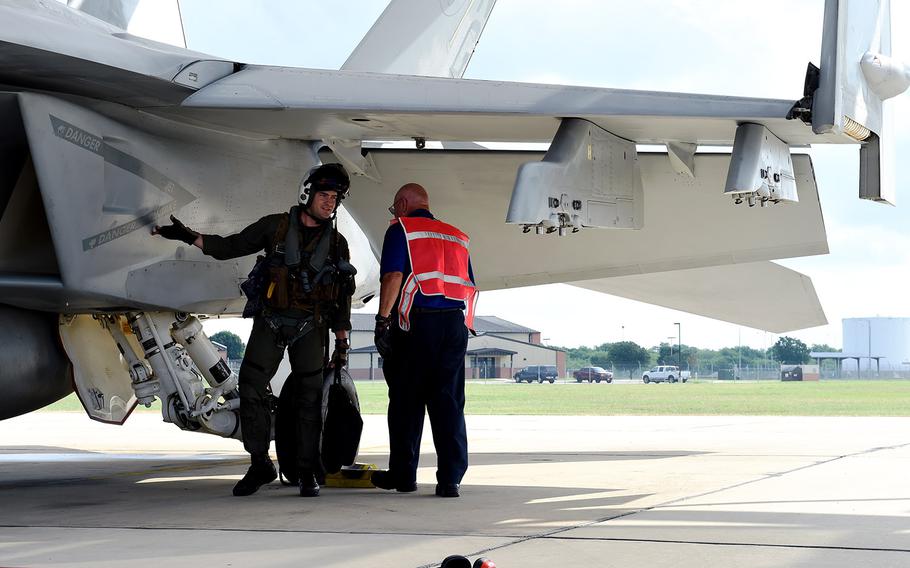
An F/A-18E Super Hornet pilot prepares for flying at Joint Base San Antonio-Lackland, Texas, in 2017. The Super Hornet fleet failed to meet target goals for mission capability readiness from 2011 to 2019, a Government Accountability Office report in November 2020 said. (Mindy Bloem/U.S. Air Force)
More than half of 46 types of military aircraft failed to meet mission capability readiness goals in any year from 2011 through 2019, including most fighter jets, a government review has found.
The Air Force’s fleet of UH-1N Iroquois “Huey” helicopters was among only three types that met or exceeded service targets in most of those years for mission capability, defined as the percentage of time they were able to fly and perform at least one mission, the Government Accountability Office said in a report this month.
The Huey, last produced at the end of the Nixon administration, exceeded targets for all nine years, GAO found. Fighter jets generally fell short in the metric used to assess the health of aircraft fleets, it said.
While each of the services set their own goals, Defense Secretary Mark Esper in September 2018 ordered that the F-22 Raptor, F-16 Fighting Falcon, F-35 Lightning II and F/A-18 variants be mission capable at least 80% of the time by the end of fiscal year 2019.
None met that goal for the full year, though Navy F-35s did hit the mark at some point, GAO found.
Military officials had warned that it would be a challenge to meet the target set by Esper, who said even he didn’t expect the F-35 to achieve the desired rate in time.
The F-22 also wasn’t expected to meet the standard due to challenges with maintenance capacity made worse by damage to Florida’s Tyndall Air Force Base from Hurricane Michael in 2018.
Members of Congress had asked the GAO to look into the condition and cost of sustaining aircraft that support combat-related missions.
After examining data on how long the aircraft are grounded for maintenance or awaiting parts, and the roughly $50 billion in annual support costs, GAO found an overall decline in annual mission capable rates across the services since 2011.
Officials attributed the trend to factors such as aging aircraft, unexpected replacements, unscheduled maintenance issues, and parts shortages and delays.
An aircraft may have multiple missions, such as a fighter jet’s bomber escort and ground-attack missions, but as long as it’s able to perform at least one of them it is considered mission capable. Last year, more than half of the aircraft types were within 15 percentage points of mission capable rate targets, but 11 fell short by 25 percentage points or more, the GAO found.
The aging F-16 and F/A-18 Hornet and Super Hornet variants failed in all nine years and saw decreasing rates of mission capability. The electronic warfare variant EA-18G Growler met service targets in only two of those years.
The F-22 Raptor, which at an average age of 12 is less than half as old as most other fighters, also failed to meet its goals nine years running, which officials attributed to degraded stealth coating, supply shortages and flying more hours than budgeted.
With an average age of four years old or less, the F-35 has long been hampered by maintenance and parts supply issues, but all three variants met their goals at least one year out of nine — two years for the Air Force and Navy variants.
The Joint Strike Fighter saw a slight improvement in its mission capable rate last year, compared to 2012, but the uptick followed a downward trend since 2015, the review found.
One of the three aircraft that generally met or exceeded goals during the period is the E-6B Mercury, which is used to link the National Command Authority with naval ballistic missile strike forces during a crisis.
Based on the Boeing 707, the Mercury hit the target five of nine years, though its mission capable rate dropped over the span due to parts obsolescence and a nearly 10% increase in maintenance hours, the report found.
The Navy’s EP-3E Aries spy planes, on average over 40 years old, met or exceeded service goals for its availability in seven of nine years, increasing slightly over that time.
While the Air Force’s fleet of Hueys met its goals, the Air Force said the airframes face challenges due to age. It plans in 2022 to begin retiring the roughly 60 remaining helicopters, which are about 47 years old on average, over about a decade.
garland.chad@stripes.com Twitter: @chadgarland